Hue, the ancient capital, serene and timeless, is not only a famous tourist destination for its poetic beauty of the Perfume River and Ngu Binh Mountain but also a place that preserves the nation’s soul through unique architectural works. The Complex of Hue Monuments, recognized by UNESCO as a World Heritage Site, is a living testament to a golden historical period of Vietnam. Let’s join “Discovery Around The World” on a journey to explore the Hue Citadel relic area, where every brick and tile contains stories of the nation’s glorious past.
Hue Citadel: A Symbol of Vietnamese Culture and History
Discovering the Unique Values of the Hue Citadel
The Hue Citadel is not just a collection of architectural structures but also a living museum, a convergence of Vietnam’s cultural, artistic, and historical essence. It was once the political, economic, and cultural center of the country under the Nguyen Dynasty, the last feudal dynasty of Vietnam. With its majestic system of citadels, palaces, tombs, and temples, Hue Citadel vividly reflects Eastern thought, culture, and feng shui, while also demonstrating the architectural and artistic talents of ancient Vietnamese people.
Recognized by UNESCO as a World Heritage Site in 1993, the Hue Citadel is of not only national but also international value. It is the pride of the Vietnamese people and an attractive destination for visitors from all over the world who want to learn about Vietnamese history, culture, and architecture. Visiting the Hue Citadel, tourists not only admire the ancient and solemn beauty of the architectural works but also immerse themselves in a cultural and historical space full of sacredness and emotion.

Explore the timeless beauty of Hue Citadel, a UNESCO-recognized World Heritage Site.
Unique Architectural and Artistic Values
The Complex of Hue Monuments is a testament to the harmonious combination of architecture and nature. The architectural works are built according to feng shui principles, integrated with the river and mountain landscape, creating a space that is both majestic and poetic, lyrical. Hue Citadel architecture bears the deep imprint of Nguyen Dynasty royal architecture, with works built from traditional materials such as wood, brick, stone, and lime mortar, intricately and meticulously carved.
The decorative art in the Hue Citadel is also very distinctive, expressed through patterns and motifs on roof tiles, columns, walls, reliefs, statues, and pháp lam (Vietnamese enamel). The patterns and motifs often feature themes of dragons, unicorns, turtles, phoenixes, flowers, and birds, expressing aspirations for prosperity, longevity, and peace. Hue art is also reflected in solemn court rituals, unique traditional festivals, and art forms such as Hue royal refined music (Nha Nhac), and royal court dances. All of these create a diverse, rich, and deeply national cultural picture.
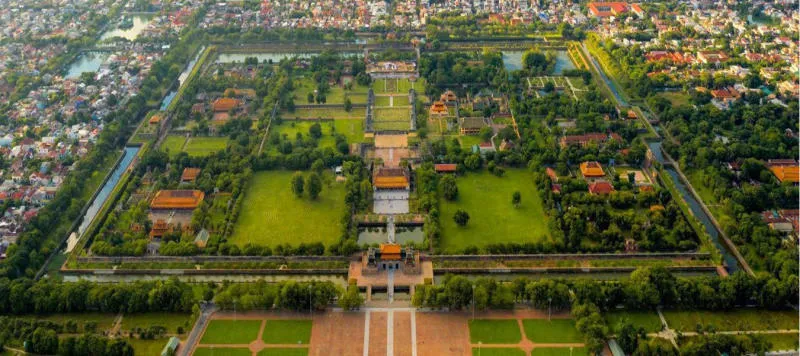
Admire the unique architecture, a convergence of historical and artistic cultural values of Hue Citadel.
Journey to Explore Prominent Destinations in Hue Citadel
Exploring Hue Imperial City: The Heart of the Citadel
The Hue Imperial City is the center of the Hue Citadel, the place where the most important architectural works of the Nguyen Dynasty are concentrated. The Imperial City was built on a large area, with a solid citadel system and deep moats surrounding it. Inside are magnificent palaces, temples, and pavilions. Visiting Hue Imperial City, tourists will admire Ngo Mon Gate, the main gate of the Imperial Citadel, Thai Hoa Palace, where the king held court, the Forbidden Purple City, the residence of the king and royal family, and The Mieu Temple, where the Nguyen Dynasty kings are worshiped.
Hue Imperial City is not only a military and administrative architectural work but also a unique work of art, demonstrating the talent and creativity of ancient Vietnamese people. Strolling through the Imperial City, visitors will feel the solemn, ancient atmosphere of a former capital, and discover historical and cultural stories hidden in each architectural work.
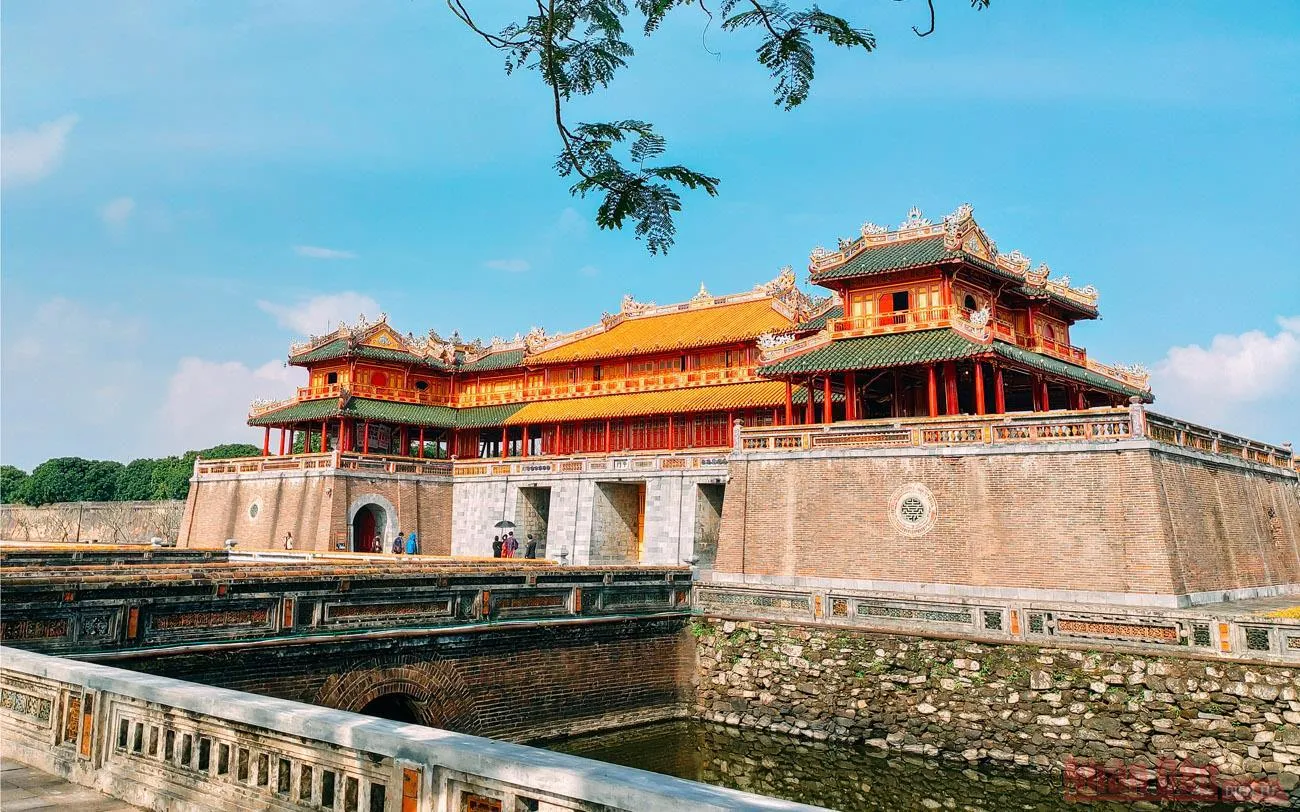
Hue Imperial City, an ancient architectural masterpiece, marking the golden age of the 13 Nguyen Dynasty kings.
Hue Flag Tower: A Historical Witness
Hue Flag Tower, also known as Ky Dai Hue, is a unique architectural work located in the middle of Hue Imperial City. The Flag Tower was built in the early 19th century as a place to hoist the court’s flags. The Flag Tower is not only of architectural value but also a historical symbol, witnessing many ups and downs of the country. From the top of the Flag Tower, visitors can take in a panoramic view of Hue Imperial City and the poetic Perfume River.
Hue Flag Tower is a must-visit destination when visiting Hue Imperial City. Here, visitors will admire the majestic and ancient beauty of the Flag Tower, and learn about the history and significance of this special architectural work.

Hue Flag Tower, a symbol of the Citadel, where the national flag flies, witnessing the changes of history.
Quoc Tu Giam Hue (Royal College): A Place for Training Talents
Quoc Tu Giam Hue was the first university in Vietnam during the Nguyen Dynasty, built in 1803. The school was a place for training talents for the country, the cradle of Vietnamese Confucian education. The architecture of Quoc Tu Giam is deeply traditional, with classrooms, worship areas, and living areas arranged harmoniously and balanced.
Today, Quoc Tu Giam Hue has become an attractive tourist destination. Here, visitors will learn about the history of Vietnamese education, admire the ancient architecture of the school, and feel the solemn and academic atmosphere of an ancient university.

Quoc Tu Giam Hue, the first university of the Nguyen Dynasty, nurturing knowledge and training talents for the country.
Hue Royal Antiquities Museum: A Treasure Trove of Art
The Hue Royal Antiquities Museum is a place to preserve and display royal artworks from the Nguyen Dynasty. The museum is located in Long An Palace, an ancient and most beautiful architectural work in Hue Imperial City. Visiting the museum, tourists will admire thousands of precious artifacts, including ceramics, bronzes, wooden objects, paintings, pháp lam, royal costumes, etc. These artifacts are not only of artistic value but also reflect the cultural and historical life of the ancient Hue court.
Hue Royal Antiquities Museum is an ideal destination for those who love art and want to learn about Vietnamese royal culture. This place will bring visitors interesting and enriching experiences about art and history.
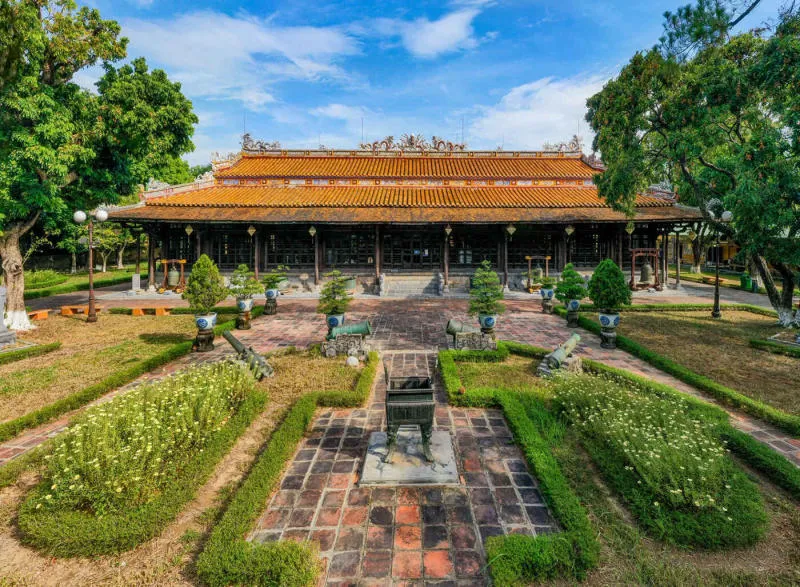
Hue Royal Antiquities Museum, preserving and displaying the artistic essence of the Nguyen Dynasty, helping visitors discover ancient royal culture.
Hoang Thanh (Imperial Citadel) of Hue: The Center of Power
The Hoang Thanh (Imperial Citadel) of Hue is the central area of Hue Imperial City, where the most important palaces of the Nguyen Dynasty are concentrated. The Imperial Citadel was built solidly, with high walls and deep moats surrounding it. Inside are magnificent palaces, temples, and pavilions. Hue Imperial Citadel was the venue for important political, diplomatic, and cultural activities of the Nguyen Dynasty court.
Exploring Hoang Thanh Hue, visitors will admire Ngo Mon Gate, Thai Hoa Palace, Dien Tho Palace, Duyet Thi Duong Theatre, Thai Mieu Temple, etc. Each architectural work in the Imperial Citadel has its own beauty, showing the sophistication and talent of ancient Vietnamese people. Hue Imperial Citadel is a must-visit destination when exploring the Hue Citadel relic area.
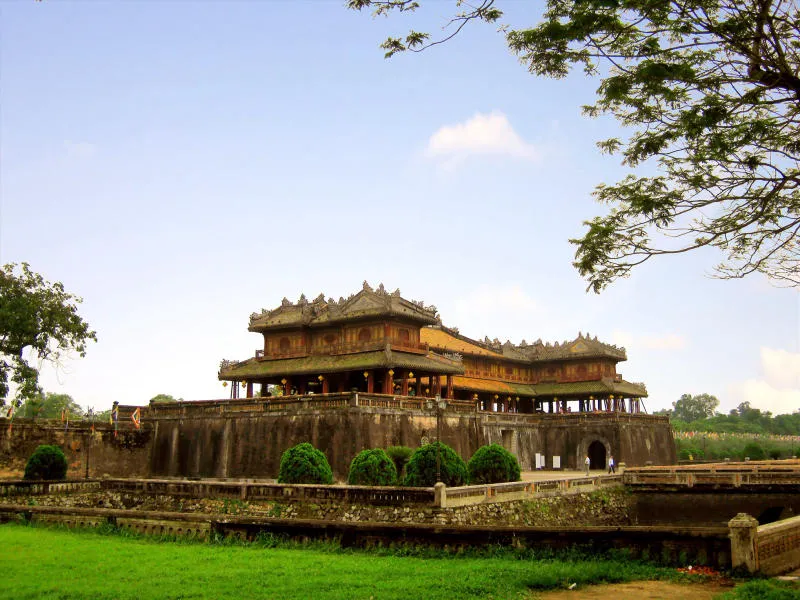
Hoang Thanh Hue, the center of power of the Nguyen Dynasty, with magnificent palace architecture and fascinating historical stories.
Hue Royal Tombs: Resting Places of Emperors
Outside Hue Imperial City is the system of tombs of the Nguyen Dynasty emperors. Each tomb is a unique architectural complex, reflecting the personality and concept of the afterlife of each emperor. Hue tombs are often built on hills, amidst poetic natural landscapes, creating a space that is both solemn and lyrical.
The most famous tombs in Hue include Gia Long Tomb, Minh Mang Tomb, Tu Duc Tomb, and Khai Dinh Tomb. Each tomb has unique architecture and its own historical story. Visiting Hue tombs, tourists not only admire the architectural beauty but also learn more about the life and career of the Nguyen Dynasty emperors.

Hue Royal Tombs, the eternal resting places of the Nguyen emperors, each tomb is a unique architectural artwork.
Tran Binh Dai (Tran Binh Bastion): An Ancient Fortress
Tran Binh Dai, also known as Don Mang Ca, is an ancient fortress located in the Northeast of Hue Imperial City. The fortress was built in the early 19th century, playing a role in protecting Hue Imperial City from the sea direction. Tran Binh Dai has unique architecture, combining Western and Eastern military architecture. To this day, Tran Binh Dai still retains its ancient and majestic appearance, being an attractive destination for tourists.
Visiting Tran Binh Dai, tourists will admire the unique architecture of the fortress, learn about the history and role of the fortress in the Hue Imperial City defense system.

Tran Binh Dai, an ancient fortress, a historical witness protecting ancient Hue Imperial City.
Phu Van Lau Pavilion: A Cultural Symbol of Hue
Phu Van Lau Pavilion is a unique architectural work located on the bank of the Perfume River, in front of the Flag Tower. Phu Van Lau Pavilion was built in the early 19th century, as a place to post important edicts of the court and organize cultural events. Phu Van Lau Pavilion has elegant architecture, harmonizing with the Perfume River landscape, being a cultural symbol of Hue.
Phu Van Lau Pavilion is a romantic and poetic destination in Hue. Here, visitors can admire the Perfume River, Trang Tien Bridge, and feel the peaceful, ancient atmosphere of the Citadel.
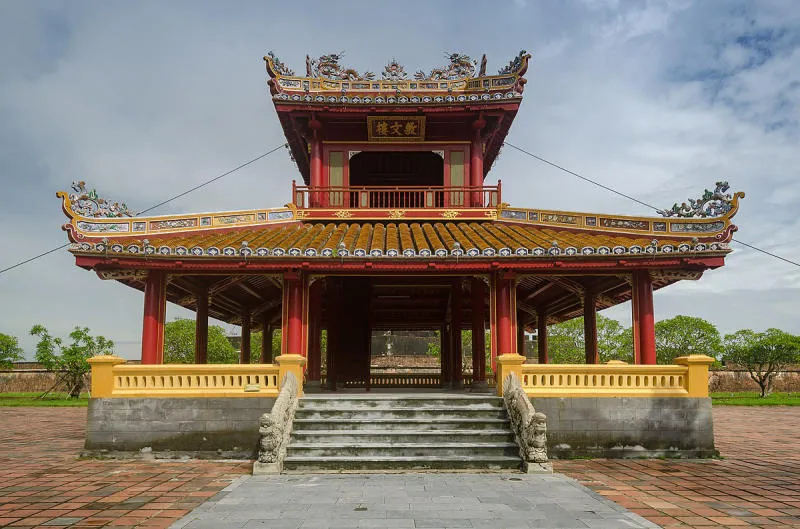
Phu Van Lau Pavilion, a cultural symbol of Hue, reflecting on the Perfume River, where important historical and cultural events took place.
Van Thanh Mieu Hue (Temple of Literature): A Place Honoring Confucianism
Van Thanh Mieu Hue is an important cultural architectural work, built in the early 19th century to worship Confucius and the sages of Confucianism. Van Thanh Mieu Hue is the center of Confucian culture in Central Vietnam. Van Thanh Mieu architecture is deeply imbued with Confucian architectural style, with temples, gardens, and lakes arranged harmoniously and solemnly.
Van Thanh Mieu Hue is an ideal destination for those who want to learn about Confucian culture and Vietnam’s tradition of studiousness. Here, visitors will feel the peaceful and solemn atmosphere of an ancient temple, and learn about the history and cultural values of Confucianism.
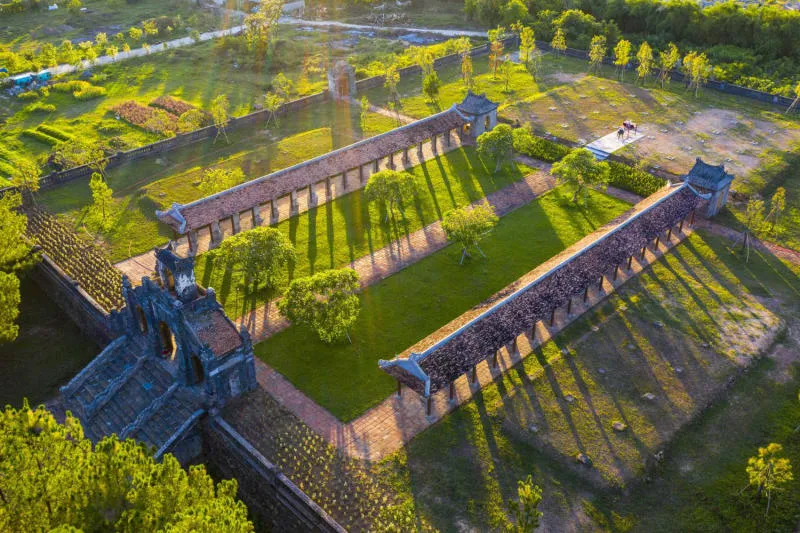
Van Thanh Mieu Hue, a place honoring Confucianism and sages, reflecting the deep-rooted Confucian cultural tradition.
Dan Nam Giao (Esplanade of Sacrifice to the Heaven and Earth): Place of Heaven and Earth Worship
Dan Nam Giao is a special religious architectural work, built in the early 19th century to worship heaven and earth, praying for favorable weather and peace for the nation. Dan Nam Giao was the venue for the most solemn heaven and earth worshiping rituals of the Nguyen Dynasty court. Dan Nam Giao architecture is deeply imbued with spiritual and mysterious elements, with altars, steps, and surrounding walls built according to feng shui principles and cosmology.
Dan Nam Giao is a unique and mystical destination in Hue. Here, visitors will learn about Vietnamese folk beliefs, admire the unique architecture of the altar, and feel the sacred and solemn atmosphere of heaven and earth worshiping rituals.

Dan Nam Giao, the place of heaven and earth worship for the Nguyen kings, deeply imbued with spiritual elements and unique architecture.
Thien Mu Pagoda: An Ancient Pagoda by the Perfume River
Thien Mu Pagoda is a famous ancient pagoda in Hue, located on the bank of the poetic Perfume River. The pagoda was built in the 17th century, one of the oldest and most beautiful pagodas in Hue. Thien Mu Pagoda is not only a spiritual site but also a famous scenic spot, attracting many tourists to visit. Thien Mu Pagoda architecture is deeply imbued with traditional Buddhist architectural style, with works such as Phuoc Duyen Tower, Dai Hung Shrine, bell tower, drum tower, etc.
Thien Mu Pagoda is a must-visit destination when traveling to Hue. Here, visitors will admire the ancient and serene beauty of the pagoda, admire the poetic Perfume River scenery, and learn about Vietnamese Buddhist history and culture.
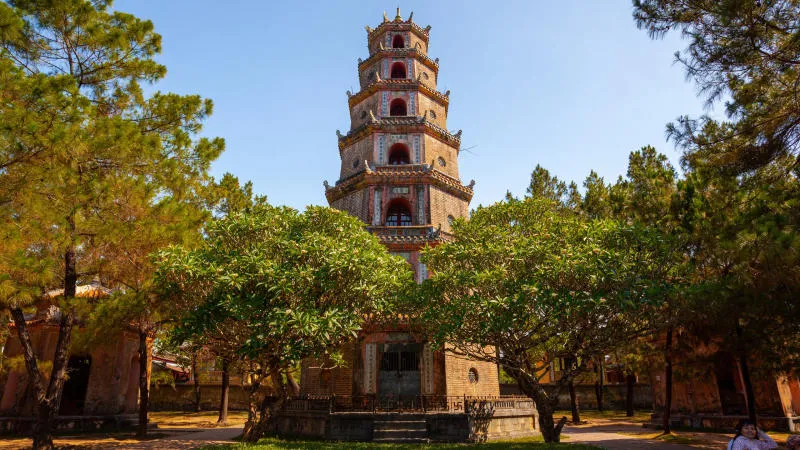
Thien Mu Pagoda, an ancient pagoda by the poetic Perfume River, a spiritual destination and famous scenic spot of Hue.
Conclusion
The Hue Citadel relic area is an attractive historical and cultural tourist destination, offering visitors unique and profound experiences about Vietnamese history, culture, and architecture. The journey to explore the Hue Citadel relic area will be a journey back in time, helping visitors better understand the nation’s glorious past and further love and be proud of the beautiful Vietnam. Come to Hue and explore the Hue Citadel relic area to fully feel the beauty and historical cultural values of the ancient capital.